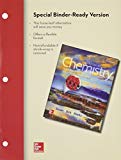
Concept explainers
Drinking water may contain a low concentration of lead ion,
(a) What is the concentration of lead ion in the tap water in units of ppb? Is it safe to drink?
(b) What is the concentration of lead ion in units of units of mg/mL?
(c) What mass of lead ion is in 100.0 mL of this drinking water?
(d) How many moles of lead ion are in 100.0 mL of the water?
(a)
Interpretation:
The concentration of
Explanation of Solution
Explanation:
Given Information: The concentration of lead ions in tap water,
Parts per million is the ratio of the mass of solute and the mass of solution multiplied by
Parts per billion is the ratio of the mass of solute and the mass of solution multiplied by
Divide equation (2) by equation (1), to get the following relationship:
Substitute the ppm value in equation (3), to obtain the ppb value as follows:
Thus, the
Since EPA has determined the maximum permissible level of
(b)
Interpretation:
The concentration of lead ions in
Explanation of Solution
Given Information: The
Parts per million is the ratio of the mass of solute and the mass of solution multiplied by
Since
So, the above equation can be written in the following manner also:
It is given that the
Hence the concentration of lead ions in
(c)
Interpretation:
The mass of lead ions present in
Explanation of Solution
Given Information:
The mass of lead ions present in
So, the mass of lead ions present in
(d)
Interpretation:
The moles of lead ions present in
Explanation of Solution
Given Information: The mass of lead ions is
The number of moles is calculated as follows:
Hence,
Want to see more full solutions like this?
Chapter 11 Solutions
Combo: Loose Leaf for Introduction to Chemistry with Connect Access Card Chemistry with LearnSmart 1 Semester Access Card
- You want to prepare a 1.0 mol/kg solution of ethyleneglycol, C2H4(OH)2, in water. Calculate the mass of ethylene glycol you would need to mix with 950. g water.arrow_forwardWhen 10. L of water is added to 3.0 L of 6.0 M H2SO4, what is the molarity of the resulting solution? Assume the volumes are additive.arrow_forwardA student weighs out a 4.80-g sample of aluminum bromide, transfers it to a 100-mL volumetric flask, adds enough water to dissolve it, and then adds water to the 100-mL mark. What is the molarity of aluminum bromide in the resulting solution?arrow_forward
- A 10.00-mL sample of a 24.00% solution of ammonium bromide (NH4Br) requires 23.41 mL of 1.200 molar silver nitrate (AgNO3) to react with all of the bromide ion present. (a) Calculate the molarity of the ammonium bromide solution. (b) Use the molarity of the solution to find the mass of ammonium bromide in 1.000 L of this solution. (c) From the percentage concentration and the answer to part b, find the mass of 1.000 L ammonium bromide solution. (d) Combine the answer to part c with the volume of 1.000 L to express the density of the ammonium bromide solution (in g/mL).arrow_forwardAcetic acid (HC2H3O2) can be prepared by the action of the acetobacter organism on dilute solutions of ethanol (C2H5OH). The equation for the reaction is C2H5OH(aq)+O2(g)HC2H3O2(aq)+H2OHow many milliliters of a 12.5% (by volume) solution of ethanol are required to produce 175 mL of 0.664 M acetic acid? (Densityofpureethanol=0.789g/mL.)arrow_forward
 Chemistry: The Molecular ScienceChemistryISBN:9781285199047Author:John W. Moore, Conrad L. StanitskiPublisher:Cengage Learning
Chemistry: The Molecular ScienceChemistryISBN:9781285199047Author:John W. Moore, Conrad L. StanitskiPublisher:Cengage Learning Chemistry: Principles and ReactionsChemistryISBN:9781305079373Author:William L. Masterton, Cecile N. HurleyPublisher:Cengage Learning
Chemistry: Principles and ReactionsChemistryISBN:9781305079373Author:William L. Masterton, Cecile N. HurleyPublisher:Cengage Learning Chemistry: Principles and PracticeChemistryISBN:9780534420123Author:Daniel L. Reger, Scott R. Goode, David W. Ball, Edward MercerPublisher:Cengage Learning
Chemistry: Principles and PracticeChemistryISBN:9780534420123Author:Daniel L. Reger, Scott R. Goode, David W. Ball, Edward MercerPublisher:Cengage Learning Chemistry & Chemical ReactivityChemistryISBN:9781133949640Author:John C. Kotz, Paul M. Treichel, John Townsend, David TreichelPublisher:Cengage Learning
Chemistry & Chemical ReactivityChemistryISBN:9781133949640Author:John C. Kotz, Paul M. Treichel, John Townsend, David TreichelPublisher:Cengage Learning World of Chemistry, 3rd editionChemistryISBN:9781133109655Author:Steven S. Zumdahl, Susan L. Zumdahl, Donald J. DeCostePublisher:Brooks / Cole / Cengage Learning
World of Chemistry, 3rd editionChemistryISBN:9781133109655Author:Steven S. Zumdahl, Susan L. Zumdahl, Donald J. DeCostePublisher:Brooks / Cole / Cengage Learning Introductory Chemistry: An Active Learning Approa...ChemistryISBN:9781305079250Author:Mark S. Cracolice, Ed PetersPublisher:Cengage Learning
Introductory Chemistry: An Active Learning Approa...ChemistryISBN:9781305079250Author:Mark S. Cracolice, Ed PetersPublisher:Cengage Learning





